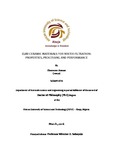| dc.description.abstract | Ceramic water filters are promising household water treatment technology, as they are capable of removing waterborne pathogens and thereby reducing diarrheal disease. Flow rates are the main quality control criterion for manufacturing, and multiple theoretical flow rate models have been published.
This dissertation presents the results of combined experimental and theoretical studies of flow rate variation in ceramic water filters in frustum-
and disk-shaped ceramic water filters. Also investigated is how clay mixtures/plasticity affects the strength of the ceramic water filters.
Furthermore, residual strengths of filter specimens that had undergone cold-shocking at temperatures 750, 850 and 950 are presented and trends explained via bridging models.
Firstly, in this dissertation six frustum-shaped ceramic water filters of the same clay:sawdust composition were tested. Each ceramic water filter was filled with water and allowed to filter 20 times. Each time, the flow rate and water level are measured for consecutive 12 hours.
Permeability values are estimated for each run of the ceramic water filters.
Statistical analysis was performed on flow rates (in the first hour), mean flow rates and estimated permeability values. The flow rate values (in the first hour) for the six ceramic water filters were found to be between 1.4 – 3.0 L/hr. An effective permeability was obtained for ceramic water filters with a range of micro- and nano-scale pore sizes. The statistical variations in the flow rates and effective permeabilities were elucidated along with the potency of a multiple ceramic water filter system for scale-up studies in serving communities that need portable water.
Secondly, a systematic literature review of the selected theoretical flow models was done. Three sets of full-size filters and disks were manufactured in triplicate by Potters without Borders (Enderby, Canada) according to Best Practice recommendations. Manufacturing specifications were selected to
achieve desired flow rates of 1 to 3 Liters per hour. Flow rate was controlled by altering: 1) firing temperature (880oC or 950oC); and, 2) burn-out material sieve size (top/bottom) (16/30 mesh or 30/60 mesh. The experimental flow data was then compared with three main models in literature describing flow through frustum-shaped ceramic water filters. Yakub et al., model was found to best describe the flow than Schweitzer et al., and Van Halem. Also, equation has been modeled to predict the frustum-shaped size ceramic water filter using the flow rate of the disk ceramic water filter as
surrogates.
Thirdly, this dissertation presents the results of an experimental study of the effects of clay mixtures on the plasticity and strengths of fired clays that are used in the processing of porous ceramic water filters for water filtration. Two clays with well characterized initial compositions (Iro and Ewuya clays) are mixed with varying proportions to control their plasticity. The clay mixtures are then fired at temperatures of 750oC, 850oC and 950oC and
their mechanical properties of mixtures determined. The results show clay mixtures with 45% - 60% of the Iro clay content and 40% - 55% Ewuya clay content can be used in the production of ceramic water filters with robust mechanical properties.
The mechanical properties of the clay mixtures sintered at 850oC were found to be generally better than those of clay mixtures sintered at 750oC and 950oC. Also presented are thermal shock study results on 50% Iro clay - 50% Ewuya clay mixture via the residual strengths measurements. The thermal shock results show that for 50% (Iro clay) - 50% (Ewuya clay) mixture renders good combination for appreciable residual strength and fracture toughness values.
The implications of the results are discussed for the mixing of locally available clays for applications in producing ceramic water filters. | en_US |

